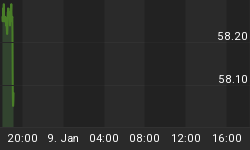Initial Reaction
For a huge change we see the existing pattern of a strong establishment survey but a poor household survey has been replaced by weakness all around.
Last month I stated "The household survey varies more widely, and the tendency is for one to catch up to the other, over time. The question, as always, is which way?"
It is still difficult to say if this is the start of a new trend, but it could be.
Last month the household survey showed a gain in employment of a meager 96,000 and much of that was teen employment. This month the household survey came in at an anemic 34,000.
The labor force declined in each of the last two months. Those "not in the labor force" rose by a whopping 631,000 in the last two months.
Huge Miss on Expectations
The Bloomberg Consensus jobs estimate was for 247,000 jobs, missing by a mile. In fact, the number came in lower than any estimate. The estimate range was 200,000 to 271,000.
Not only that, January and February were both revised lower. The net was 69,000 lower.
Economists blame the weather. Bad weather in March? And not in January and February?
Let's take a look at all the key numbers.
BLS Jobs Statistics at a Glance
- Nonfarm Payroll: +126,000 - Establishment Survey
- Employment: +34,000 - Household Survey
- Unemployment: -130,000 - Household Survey
- Involuntary Part-Time Work: +70,000 - Household Survey
- Voluntary Part-Time Work: -104,000 - Household Survey
- Baseline Unemployment Rate: +0.0 at 5.5% - Household Survey
- U-6 unemployment: -0.1 to 10.9% - Household Survey
- Civilian Non-institutional Population: +181,000
- Civilian Labor Force: -96,000 - Household Survey
- Not in Labor Force: +277,000 - Household Survey
- Participation Rate: -0.1 at 62.7 - Household Survey
March 2015 Employment Report
Please consider the Bureau of Labor Statistics (BLS) Current Employment Report.
Total nonfarm payroll employment increased by 126,000 in March, and the unemployment rate was unchanged at 5.5 percent, the U.S. Bureau of Labor Statistics reported today. Employment continued to trend up in professional and business services, health care, and retail trade, while mining lost jobs.
Unemployment Rate - Seasonally Adjusted

Nonfarm Employment January 2012 - March 2015
Nonfarm Employment Change from Previous Month by Job Type

Hours and Wages
Average weekly hours of all private employees declined by 0.1 to 34.5 hours. Average weekly hours of all private service-providing employees was flat at 33.4 hours.
Average hourly earnings of production and non-supervisory private workers rose $0.04 at $20.86. Average hourly earnings of production and non-supervisory private service-providing employees rose $0.03 at $20.66.
For discussion of income distribution, please see What's "Really" Behind Gross Inequalities In Income Distribution?
Birth Death Model
Starting January 2014, I dropped the Birth/Death Model charts from this report. For those who follow the numbers, I retain this caution: Do not subtract the reported Birth-Death number from the reported headline number. That approach is statistically invalid. Should anything interesting arise in the Birth/Death numbers, I will add the charts back.
Table 15 BLS Alternate Measures of Unemployment

Table A-15 is where one can find a better approximation of what the unemployment rate really is.
Notice I said "better" approximation not to be confused with "good" approximation.
The official unemployment rate is 5.5%. However, if you start counting all the people who want a job but gave up, all the people with part-time jobs that want a full-time job, all the people who dropped off the unemployment rolls because their unemployment benefits ran out, etc., you get a closer picture of what the unemployment rate is. That number is in the last row labeled U-6.
U-6 is much higher at 10.9%. Both numbers would be way higher still, were it not for millions dropping out of the labor force over the past few years.
Some of those dropping out of the labor force retired because they wanted to retire. The rest is disability fraud, forced retirement, discouraged workers, and kids moving back home because they cannot find a job.
For further discussion of a more accurate measure of the unemployment rate, please see Gallup CEO Calls 5.6% Unemployment Rate "The Big Lie": What's a Realistic Unemployment Rate?
















